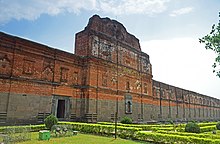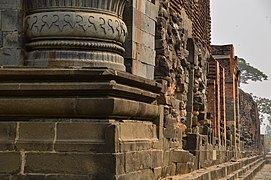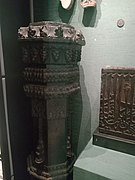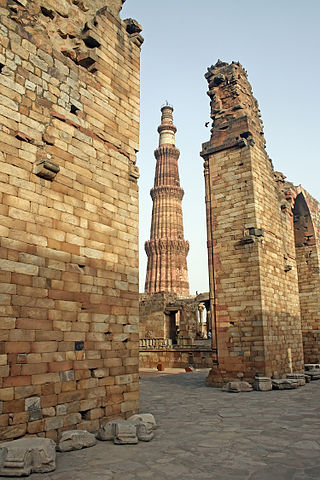
The Qutb Minar complex are monuments and buildings from the Delhi Sultanate at Mehrauli in Delhi, India. Construction of the Qutub Minar "victory tower" in the complex, named after the religious figure Sufi Saint Khwaja Qutbuddin Bakhtiar Kaki, was begun by Qutb-ud-din Aibak, who later became the first Sultan of Delhi of the Mamluk dynasty. It was continued by his successor Iltutmish, and finally completed much later by Firoz Shah Tughlaq, a Sultan of Delhi from the Tughlaq dynasty (1320–1412) in 1368 AD. The Qubbat-ul-Islam Mosque, later corrupted into Quwwat-ul Islam, stands next to the Qutb Minar.

Lodi Gardens is a city park situated in New Delhi, India. Spread over 90 acres (360,000 m2), it contains Mohammed Shah's Tomb, the Tomb of Sikandar Lodi, the Shisha Gumbad and the Bara Gumbad, architectural works of the 15th century by Lodis - who ruled parts of northern India and Punjab and Khyber Pakhtunkhwa province of modern-day Pakistan, from 1451 to 1526 are present here. The site is now protected by the Archaeological Survey of India (ASI).
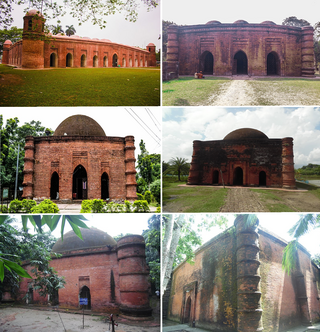
The Mosque City of Bagerhat is a UNESCO World Heritage Site in Bagerhat District, Bangladesh. It contains 360 mosques, public buildings, mausoleums, bridges, roads, water tanks and other public buildings constructed from baked brick. The mosques were built during the Bengal Sultanate in the 15th century, of which the Sixty Dome Mosque is the largest. Other mosques include the Singar Mosque, the Nine Dome Mosque, the Tomb of Khan Jahan, the Bibi Begni Mosque and the Ronvijoypur Mosque. The mosques were built during the governorship of Ulugh Khan Jahan, a Turkic military officer appointed as governor in the Sundarbans by Sultan Mahmud Shah of Bengal.

Gauḍa is a historic city of Bengal in the eastern part of the Indian subcontinent, and one of the most prominent capitals of classical and medieval India, being the capital city of Bengal under several kingdoms. The Gauḍa region was also a province of several pan-Indian empires. During the seventh century, the Gauda Kingdom was founded by King Shashanka, whose reign corresponds with the beginning of the Bengali calendar. Gour gradually became synonymous with Bengal and Bengalis. It was conquered by Bakhtiyar Khalji, a lieutenant of the Ghurid ruler Muhammad of Ghori in 1203.

Indo-Islamic architecture is the architecture of the Indian subcontinent produced by and for Islamic patrons and purposes. Despite an initial Arab presence in Sindh, the development of Indo-Islamic architecture began in earnest with the establishment of Delhi as the capital of the Ghurid dynasty in 1193. Succeeding the Ghurids was the Delhi Sultanate, a series of Central Asian dynasties that consolidated much of North, East, and Central India, and later by the Mughal Empire during the early 16th century. Both of these dynasties introduced Islamic architecture and art styles from West Asia into the Indian subcontinent.

Pandua, also historically known as Hazrat Pandua and later Firuzabad, is a ruined city in the Malda district of the Indian state of West Bengal. It served as the capital city of the independent Sultanate of Bengal for nearly a century, until the capital was moved to nearby Lakhnauti in 1450.

Nāṣiruddīn Maḥmūd Shāh was the first Sultan of Bengal belonging to the restored Ilyas Shahi dynasty. Formerly a farmer, he was selected as the next ruler of Bengal by the erstwhile nobility in 1435 CE, and ruled the country for over twenty years. During his peaceful reign, Bengal saw significant architectural development.

The Architecture of Bengal, which comprises the modern country of Bangladesh and the Indian states of West Bengal, Tripura and Assam's Barak Valley, has a long and rich history, blending indigenous elements from the Indian subcontinent, with influences from different parts of the world. Bengali architecture includes ancient urban architecture, religious architecture, rural vernacular architecture, colonial townhouses and country houses and modern urban styles. The bungalow style is a notable architectural export of Bengal. The corner towers of Bengali religious buildings were replicated in medieval Southeast Asia. Bengali curved roofs, suitable for the very heavy rains, were adopted into a distinct local style of Indo-Islamic architecture, and used decoratively elsewhere in north India in Mughal architecture.

Shamsuddin Ilyas Shah was the founder of the Sultanate of Bengal and its inaugural Ilyas Shahi dynasty. The Ilyas Shahi Dynasty ruled Bengal for 145 years (1342–1487), except for a 21-year interregnum by the descendants of Raja Ganesha. Ilyas Shah was instrumental in unifying the principalities of Bengal into a single state.
Abul Mujāhid Sikandar Shāh, commonly known as Sikandar Shah; was the second Sultan of Bengal and the Ilyas Shahi dynasty. He was the son of Shamsuddin Ilyas Shah. Sikandar Shah continued to project the imperial ambitions of his father. He defeated the Sultan of Delhi in 1359. His reign is also noted for its grandiose architectural projects.

Jalaluddin Muhammad Shah was a 15th-century Sultan of Bengal and an important figure in medieval Bengali history. Born a Hindu to his aristocratic father Raja Ganesha, the patriarch of the Ganesha dynasty, he assumed the throne of Bengal after a coup which overthrew the Ilyas Shahi dynasty. He converted to Islam and ruled the Bengal Sultanate for 16 years. As a Muslim king, he brought Arakan under Bengali suzerainty and consolidated the kingdom's domestic administrative centres. He pursued relations with the Timurid Empire, Mamluk Egypt and Ming China. Bengal grew in wealth and population during his reign. He also combined Bengali and Islamic architecture.

The Bengal Sultanate was a late medieval sultanate based in the Bengal region in the eastern South Asia between the 14th and 16th century. It was the dominant power of the Ganges-Brahmaputra Delta, with a network of mint towns spread across the region. The Bengal Sultanate had a circle of vassal states in the Indian subcontinent, including parts of Odisha in the southwest, Arakan in the southeast, and Tripura in the east.

Sultan Ghari was the first Islamic Mausoleum (tomb) built in 1231 AD for Prince Nasiruddin Mahmud, eldest son of Iltumish, in the "funerary landscape of Delhi" in the Nangal Dewat Forest, Near Nangal Dewat Vasant Kunj).

Choto Shona Mosque is located in Chapai Nawabganj district of Bangladesh. The mosque is situated about 3 kilometres (1.9 mi) south of the Kotwali Gate and 0.5 kilometres (0.31 mi) to the south-east of the Mughal Tahakhana complex in the Firozpur Quarter.
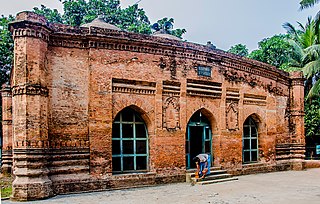
Baba Adam's Mosque is a mosque situated in the village of Qadi Qasbah under Rampal Union of Bangladesh's Munshiganj District. It was constructed in 1483 A.D by Malik Kafur to function as a Jami mosque during the reign of Jalaluddin Fateh Shah. The tomb of Baba Adam Shahid, a 15th-century Muslim preacher, lies near the edifice.

Baro Shona Masjid, also known as Baroduari Masjid, is located in Gour, West Bengal, India. Completed in 1526, it is situated half a kilometer south of Ramkeli, a village on the way to Gour, and 12 km south of Malda. The mosque with its ruins can be found very close to the India-Bangladesh border. With a gigantic rectangular structure of brick and stone, this mosque is the largest monument in Gour. Even though one of the mosque's names "Baroduari Masjid" implies that it has 12 doors, it actually has eleven in its current state.

Persian Inscriptions on Indian Monuments is a book written in Persian by Dr Ali Asghar Hekmat E Shirazi and published in 1956 and 1958 and 2013. New edition contains the Persian texts of more than 200 epigraphical inscriptions found on historical monuments in India, many of which are currently listed as national heritage sites or registered as UNESCO world heritage, published in Persian; an English edition is also being printed.
Tughlaq Tombs in the Indian subcontinent are mostly simple, monotonous and heavy structures in Indo-islamic architecture built during the Tughlaq dynasty (1320–1413). They look more like fortresses with walls surrounding them and have restrained decoration and embellishment compared to both earlier and later Indian Islamic tombs. Their architecture lacks the influence from Dravidian architecture and craftsmanship which was later found in Lodi and Mughal architecture. But Dravidian architecture influence on Tughlaq buildings was not totally absent. Features of Hindu influences on Tughlaq architecture include the flat lintel instead of pointed arch, pillars, windows with balconies and eaves and railings.

Eklakhi Mausoleum is a mausoleum located at Pandua in Malda district, West Bengal, India. It was built around 1425. It houses three tombs, possibly belonging to Sultan Jalaluddin Muhammad Shah, his wife, and son Shamsuddin Ahmad Shah, but the identification is disputed. The structure represents a village hut with a sloping roof and serves as a prototype for the various other buildings constructed during the Bengal Sultanate.
Faqir Mosque is an oblong six-domed Islamic place of worship in Bangladesh's Chittagong District. The fifteenth-century mosque dates back to the Bengal Sultanate period.
